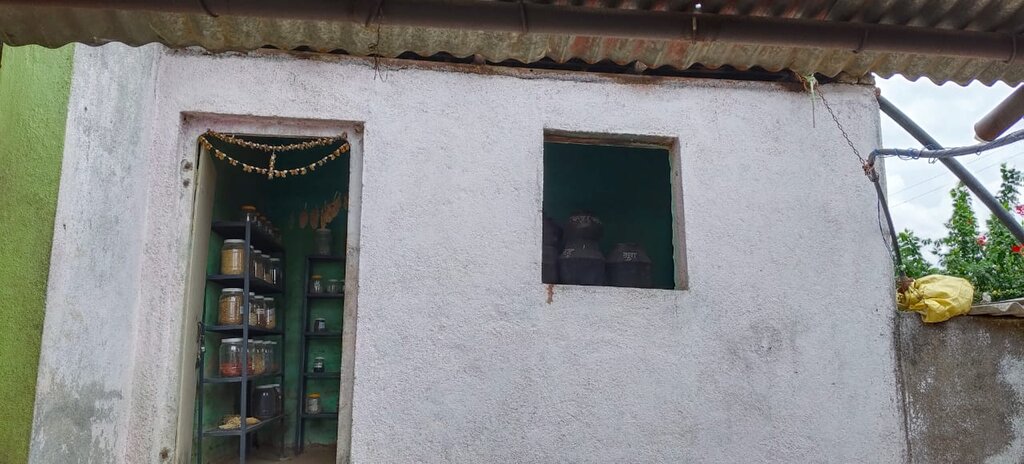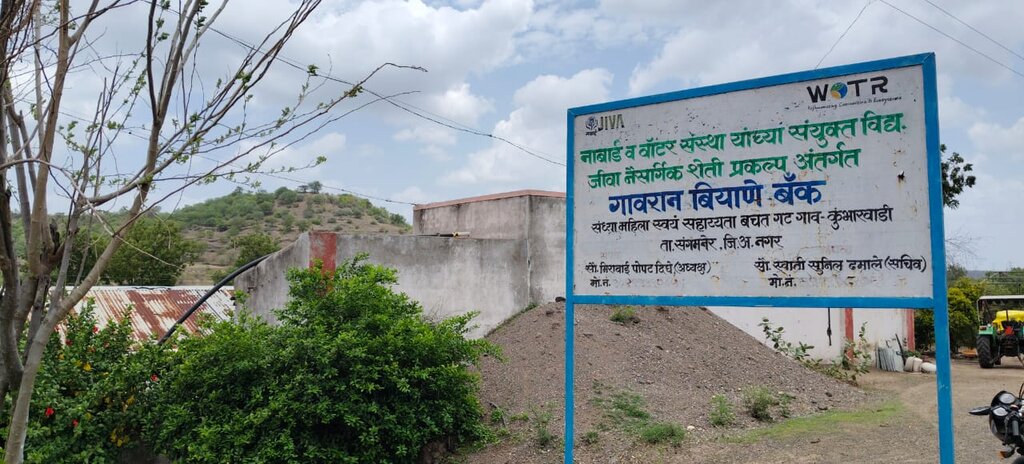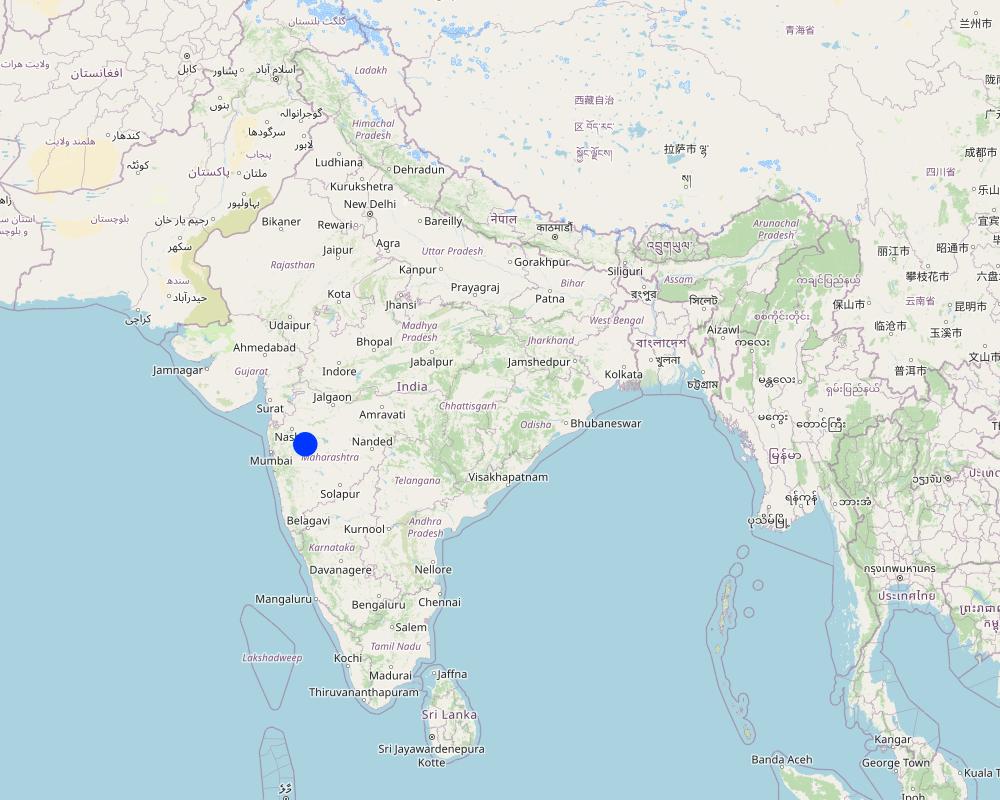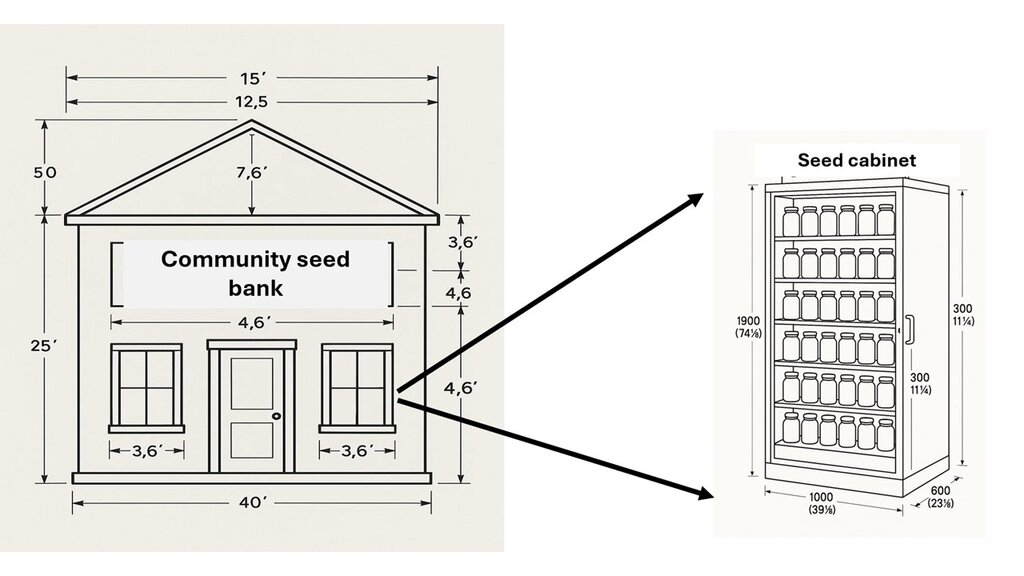Community seed banks [الهند]
- تاريخ الإنشاء:
- تحديث:
- جامع المعلومات: Pratik Ramteke
- المحرر: –
- المراجعون: Rima Mekdaschi Studer, William Critchley
Seed banks
technologies_7552 - الهند
عرض الأقسام
توسيع الكل طي الكل1. معلومات عامة
1.2 تفاصيل الاتصال بالأشخاص الرئيسيين لمصدر المعلومات والمؤسسات المشاركة في تقييم وتوثيق التقنية
اسم المشروع الذي سهّل توثيق/تقييم التقنية (إذا كان ذلك على صلة)
Enabling Agro-ecological Transitions in Rainfed Landscapes (JIVA)اسم المؤسسة (المؤسسات) التي سهلت توثيق/تقييم التقنية (إذا كان ذلك على صلة)
Watershed Organisation Trust (WOTR) - الهند1.3 الشروط المتعلقة باستخدام البيانات الموثقة من خلال WOCAT
يوافق جامع المعلومات والشخص (لاشخاص) الرئيسي لمصدر المعلومات على الشروط المتعلقة باستخدام البيانات الموثقة من خلال WOCAT:
نعم
1.4 إعلان بشأن استدامة التقنية الموصوفة
هل التقنية الموصوفة هنا تمثل مشكلة فيما يتعلق بتدهور الأراضي، بحيث لا يمكن إعلانها تقنية مستدامة لإدارة الأراضي؟:
كلا
2. وصف تقنيةالإدارة المستدامي للأراضي
2.1 وصف مختصر للتقنية
تعريف التقنية:
A community-based seed bank system is a locally managed initiative where farmers and community members collect, store, and share seeds to ensure germplasm and food security, preserve crop diversity, and support sustainable agriculture. These banks are governed by community rules.
2.2 وصف تفصيلي للتقنية
الوصف:
Community Seed Banks (CSBs) are locally governed systems designed to enhance food and seed security, promote sustainable, climate-resilient farming as well as conserving agrobiodiversity. CSBs bridge traditional agricultural knowledge with evolving best practices, ensuring the continuity of seed diversity adapted to local conditions.
A key function of CSBs is seed preservation and exchange. They provide for the collection of seeds from farmers, prioritizing varieties that have demonstrated superior local adaptation. Seeds are carefully cleaned, dried, and tested for viability before being stored—typically in clay pots in a simple building. The preserved seeds can be used in future planting seasons or distributed during droughts, floods, or pest outbreaks, thereby ensuring timely access to reliable seed material.
A CBS conserves and manages a diverse range of locally important crops including both cereals (sorghum and maize) and legumes (black grams, chickpeas, cowpeas, green grams, green peas, groundnuts, horse grams, red grams, and soybeans). Several traditional and improved cultivars of each crop are stored, selected on their performance under local conditions, including drought tolerance, pest and disease resistance, yield stability, and cultural preference. The quantity of seeds stored per cultivar ranges from 500 grams to 100 kilograms, depending on availability and community demand. For seed protection, both indigenous practices and materials such as wood ash, neem leaves (Azadirachta indica), and chili extract (Capsicum frutescens) are used to prevent pest infestation during storage, minimizing reliance on commercial pesticides.
Management of CSBs is local and participatory. They are generally governed by elected community committees that set the rules for deposit, withdrawal and replenishment. This governance structure ensures that the seed bank reflects the specific needs and knowledge systems of the community. Community engagement is not only vital for operational success but also fosters a sense of ownership and collective responsibility.
CSBs play a multifaceted role. They contribute to agrobiodiversity conservation by safeguarding traditional and wild crop varieties, which are invaluable for future breeding programs. Furthermore, they ensure that farmers can access seeds during critical periods. Additionally, CSBs promote sustainable agricultural practices by reducing reliance on commercial seed systems. They also help to document and share traditional farming knowledge.
The operational structure of a CSB begins with community mobilization and capacity-building focused on seed selection, handling, and storage. Infrastructure requirements are modest. Maintenance involves tasks such as viability testing to ensure the germination potential of stored seeds.
CSBs enhance the resilience of agricultural systems by enabling communities to recover swiftly from crop failures: they also reduce input costs. Furthermore, CSBs empower communities—particularly smallholder farmers and women. Moreover, these banks store vital genetic material for future research.
From a community perspective, the benefits are substantial. However, challenges remain. High initial investments in infrastructure and training are required, and ongoing success depends on strong community engagement and diligent record-keeping. Nevertheless, by preserving the genetic heritage of crops and empowering local communities, CSBs reduce contribute to food sovereignty
2.3 صور التقنية
2.5 البلد/المنطقة/المواقع التي تم تنفيذ التقنية فيها والتي يغطيها هذا التقييم
البلد:
الهند
المنطقة/الولاية/المحافظة:
Maharashtra
مزيد من التفاصيل حول الموقع:
Kumbharwadi village, Tal. Sangamner, Dist: Ahilyanagar
حدد انتشار التقنية:
- يتم تطبيقها في نقاط محددة/ تتركز على مساحة صغيرة
هل يقع موقع/مواقع التقنية في منطقة محمية بشكل دائم؟:
كلا
التعليقات:
This documentation covers a single CSB located at Kumbharwadi village.
Map
×2.6 تاريخ التنفيذ
اذكر سنة التنفيذ:
2024
2.7 إدخال التقنية
حدد كيف تم إدخال التقنية:
- من خلال المشاريع/ التدخلات الخارجية
التعليقات (نوع المشروع، الخ):
JIVA – An Agroecology-Based Programme, Implementing Agency: National Bank for Agriculture and Rural Development (NABARD)
3. تصنيف تقنية الإدارة المستدامي للأراضي
3.1 الغرض الرئيسي ( الأغراض الرئيسية) للتقنية
- تحسين الإنتاج
- الحفاظ على/تحسين التنوع البيولوجي
- التكيف مع تغير المناخ/الظواهر المتطرفة وآثارها
- خلق أثر اقتصادي مفيد
- خلق أثر اجتماعي مفيد
3.2 نوع (أنواع) استخدام الأراضي الحالية حيث يتم تطبيق التقنية
استخدامات الأراضي مختلطة ضمن نفس وحدة الأرض:
نعم
حدد استخدام الأراضي المختلطة (المحاصيل / الرعي / الأشجار):
- الحراجة الزراعية

الأراضي الزراعية
- زراعة سنوية
- زراعة الأشجار والشجيرات
الزراعة السنوية - حدد المحاصيل:
- الحبوب - الذرة
- الحبوب - الدخن
- محاصيل الأعلاف - البرسيم (الفصة)
- الحبوب البقولية والبقول -فول الصويا
- الخضروات - الخضروات الجذرية (الجزر والبصل والشمندر وغيرها)
زراعة الأشجار والشجيرات -حدد المحاصيل:
- المانجو، المانغوستين، الجوافة
- Custard Apple
عدد مواسم الزراعة في السنة:
- 2
هل يتم ممارسة الزراعة البينية؟:
نعم
إذا كانت الإجابة بنعم، حدد المحاصيل التي يتم زراعتها بشكل بيني:
Red gram, black gram and green gram intercropped with pearl millet or soybean;
cowpea, horse gram intercropped with groundnuts
هل تتم ممارسة تناوب المحاصيل؟:
نعم
إذا كانت الإجابة بنعم، حدد:
Cereals-pulses

الغابات/ الأراضي الحرجية
- زراعة الأشجار، التشجير

المجاري المائية، المسطحات المائية، الأراضي الرطبة
- البرك والسدود
المنتجات / الخدمات الرئيسية:
Irrigation and domestic use
3.3 هل تغير استخدام الأراضي نتيجة لتنفيذ التقنية؟
هل تغير استخدام الأراضي نتيجة لتنفيذ التقنية؟:
- لا (تابع مع السؤال 3.4)
3.4 إمدادات المياه
إمدادات المياه للأرض التي يتم تنفيذ التقنية عليها:
- مختلط بعلي-مروي
التعليقات:
Irrigation source: well, farm pond
3.5 مجموعةالإدارة المستدامة للأراضي التي تنتمي إليها هذه التقنية
- الإدارة المتكاملة للآفات والأمراض (بما في ذلك الزراعة العضوية)
- تحسين أصناف النباتات/سلالات الحيوانات
- الحد من مخاطر الكوارث بالاستناد على النظام البيئي
3.6 التدابير التقنية في مجال إلادارة المستدامة للأراضي

التدابير البنيوية
- S9: إنشاءات حماية النباتات وملاجىء الحيوانات
- S11: غير ذلك
التعليقات:
The CSB includes permanent infrastructure (e.g., a small house or storage facility built with community effort) for the secure preservation and storage of seeds.
3.7 الأنواع الرئيسية من تدهور الأراضي التي تناولتها التقنية

التدهور الكيميائي للتربة
- (Cn): تراجع الخصوبة وانخفاض محتوى المادة العضوية (غير ناتج عن الانجراف)

التدهور البيولوجي
- (Bh): فقدان الموائل
- (Bs): انخفاض جودة وتركيبة الأنواع/التنوع
- (Bp): زيادة الآفات/الأمراض، وفقدان الحيوانات المفترسة

تدهور المياه
- (Hg): التغير في مستوى المياه الجوفية/الطبقة المائية الجوفية

آخر
حدد:
Agrobiodiversity loss and climate-related seed insecurity
→ The CSB addresses the degradation of crop genetic resources, which is a foundational pillar of sustainable land management.
3.8 منع أو حد أو عكس تدهور الأراضي
تحديد هدف التقنية فيما يتعلق بتدهور الأراضي:
- منع تدهور الأراضي
- الحد من تدهور الأراضي
التعليقات:
→ By conserving traditional seed varieties that require fewer external inputs, the CSB helps prevent soil and biodiversity degradation.
→ Promoting resilient, diverse, and low-input seed systems contributes to reducing ongoing degradation (e.g., fertility decline, loss of biodiversity).
4. المواصفات الفنية، وأنشطة التنفيذ، والمدخلات، والتكاليف
4.1 الرسم الفني للتقنية
المواصفات الفنية (المتعلقة بالرسم الفني):
The structure shown is for reference. Any enclosed room with suitable ventilation and storage conditions can serve as a seed bank.
More detail of storage pots and a brief description:
The seed bank utilizes traditional earthen pots (locally known as matka or bharani) and airtight glass/plastic jars as primary storage containers. The large clay pots are arranged on raised platforms and shelves to avoid moisture contact from the floor. These pots are labelled in local script (Marathi), clearly indicating the crop name (e.g., sorghum, cowpea, maize, etc.) and variety stored. Each pot is covered with cloth and tied securely, ensuring ventilation while preventing pest entry.
These earthen pots are ideal for seed storage in rural, low-cost setups as they:
•Maintain cool internal temperatures, reducing seed deterioration.
•Are naturally aerated, preventing moisture buildup.
•Can be easily sealed using cloth or organic sealants like cow dung or ash to control pests.
The glass and plastic jars used on metal racks are suited for small seed quantities, mainly for short-term storage or display during training sessions and exchanges. Each jar is labelled with variety and harvest details, supporting proper documentation and traceability.
المؤلف:
Pratik Ramteke
التاريخ:
12/05/2025
4.2 معلومات عامة بخصوص حساب المدخلات والتكاليف
حدد كيفية احتساب التكاليف والمدخلات:
- لكل وحدة تقنية
حدد الوحدة:
1
حدد أبعاد الوحدة (إذا كانت ذات صلة):
A typical unit consists of a single room structure (approx. 10 x 10 feet) equipped with traditional clay pots (15–25 units) and glass or plastic jars (20–50 units) used for storing seeds. The average storage capacity of one unit is approximately 200–500 kg, depending on the number of crop varieties and seasonal seed availability.
عملة أخرى/ عملة وطنية (حدد):
Indian Rupees
إذا كان ذا صلة، وضح سعر الصرف من الدولار الأمريكي إلى العملة المحلية (على سبيل المثال، 1 دولار أمريكي = 79.9 ريال برازيلي): 1 دولار أمريكي =:
84,0
اذكر متوسط تكلفة أجر العمالة المستأجرة في اليوم الواحد:
500
4.3 أنشطة التأسيس
| النشاط | التوقيت (الموسم) | |
|---|---|---|
| 1. | Site selection for seed bank structure (within SHG household/community building) | February–March (before Rabi harvest) |
| 2. | Construction/preparation of storage structure (room cleaning, plastering, shelf fixing) | March–April |
| 3. | Procurement of local seed varieties | April–May (before monsoon/ Kharif sowing) |
| 4. | Procurement and setup of seed storage containers (clay pots, glass jars, bags) | April–May (before onset of rain) |
| 5. | Installation of racks, shelves, moisture absorbers | May |
| 6. | Labelling of containers and organization of storage system | May–June |
| 7. | Setup of documentation tools (register books, seed stock cards) | June (onset of monsoon) |
4.4 التكاليف والمدخلات اللازمة للتأسيس
| تحديد المدخلات | الوحدة | الكمية | التكاليف لكل وحدة | إجمالي التكاليف لكل مدخل | % من التكاليف التي يتحملها مستخدمو الأراضي | |
|---|---|---|---|---|---|---|
| العمالة | Trainer Fees | person days | 1,0 | 2500,0 | 2500,0 | |
| معدات | Furniture / Rack | pieces | 10,0 | 800,0 | 8000,0 | |
| معدات | Seed Store Jar and Bag | pieces | 200,0 | 20,0 | 4000,0 | |
| المواد النباتية | Purchase of seed | kg | 50,0 | 450,0 | 22500,0 | |
| غير ذلك | Training food charges, materials, boards, exposure visit charges, register book, charts, etc. | 1,0 | 8100,0 | 8100,0 | ||
| إجمالي تكاليف إنشاء التقنية | 45100,0 | |||||
| إجمالي تكاليف إنشاء التقنية بالدولار الأمريكي | 536,9 | |||||
إذا تحمل مستخدم الأرض أقل من 100% من التكاليف، حدد من قام بتغطية التكاليف المتبقية:
Project
التعليقات:
Around 90-95% of costs were supported by the implementing project JIVA (NABARD), while the remaining was contributed by the community through local materials and voluntary labour
4.5 الصيانة/الأنشطة المتكررة
| النشاط | التوقيت/الوتيرة | |
|---|---|---|
| 1. | Labour (e.g., supervision, helpers) | each cropping season |
| 2. | Replacement of broken jars | as per need |
| 3. | Labelling changes (charts, tags) | annually |
| 4. | Equipment maintenance and repair | as per need |
4.6 التكاليف والمدخلات اللازمة للصيانة/للأنشطة المتكررة (سنويًا)
| تحديد المدخلات | الوحدة | الكمية | التكاليف لكل وحدة | إجمالي التكاليف لكل مدخل | % من التكاليف التي يتحملها مستخدمو الأراضي | |
|---|---|---|---|---|---|---|
| العمالة | Labour (e.g., supervision, helpers) | man-days | 10,0 | 300,0 | 3000,0 | |
| معدات | Replacement of broken jars | pieces | 10,0 | 20,0 | 200,0 | |
| معدات | Labelling changes (charts, tags) | 5,0 | 300,0 | 1500,0 | ||
| معدات | Equipment maintenance and repair | 1,0 | 2000,0 | 2000,0 | ||
| المواد النباتية | 1,0 | |||||
| إجمالي تكاليف صيانة التقنية | 6700,0 | |||||
| إجمالي تكاليف صيانة التقنية بالدولار الأمريكي | 79,76 | |||||
إذا تحمل مستخدم الأرض أقل من 100% من التكاليف، حدد من قام بتغطية التكاليف المتبقية:
Project (see above under Establishment)
4.7 أهم العوامل المؤثرة على التكاليف
قدم وصفا لأهم العوامل التي تؤثر على التكاليف:
1. Seed procurement and quality maintenance
2. Storage infrastructure (jars, bags, racks)
3. Training and capacity building for SHGs
4. Labelling and documentation materials
5. Community engagement and operational labour
6. Monitoring and evaluation activities
7. Exposure visits and knowledge sharing
8. Replacement and maintenance of storage materials
5. البيئة الطبيعية والبشرية
5.1 المناخ
هطول الأمطار السنوي
- < 250 مم
- 251- 500 ملم
- 501 - 750ملم
- 1,000-751 ملم
- 1,500-1,100 ملم
- 2,000-1,500 ملم
- 3,000-2,001 ملم
- 4,000-3,100 ملم
- > 4000 ملم
حدد متوسط هطول الأمطار السنوي (إذا كان معروفًا)، بالملليمتر:
450,00
المنطقة المناخية الزراعية
- شبه قاحلة
5.2 طوبوغرافيا
متوسط الانحدارات:
- مسطح (0-2%)
- بسيط (3-5%)
- معتدل (6-10%)
- متدحرج (11-15%)
- تلال (16-30%)
- شديدة الانحدار(31-60%)
- فائقة الانحدار (>60%)
التضاريس:
- هضاب/سهول
- أثلام مرتفعة
- المنحدرات الجبلية
- منحدرات التلال
- منحدرات في السفوح
- قاع الوادي
المنطقة الارتفاعية:
- 100-0 متر فوق سطح البحر
- 500-101 متر فوق سطح البحر
- 1,000-501 متر فوق سطح البحر
- 1,500-1,001 متر فوق سطح البحر
- 2,000-1,501 متر فوق سطح البحر
- 2,500-2,100 متر فوق سطح البحر
- 3,000-2,501 متر فوق سطح البحر
- 4,000-3,001 متر فوق سطح البحر
- > 4000 متر فوق سطح البحر
وضح ما إذا كانت التقنية مطبقة على وجه التحديد في:
- غير ذات صلة
5.3 التربة
متوسط عمق التربة:
- ضحل جدًا (0-20 سم)
- ضحلة (21-50 سم)
- متوسطة العمق (51-80 سم)
- عميقة (81-120 سم)
- عميقة جدًا (> 120 سم)
قوام التربة (التربة السطحية):
- خشن / خفيف (رملي)
قوام التربة (> 20 سم تحت السطح):
- خشن / خفيف (رملي)
المواد العضوية في التربة السطحية:
- منخفضة (<1%)
إذا كان متاحًا، قم بإرفاق وصف كامل للتربة أو تحديد المعلومات المتوفرة، على سبيل المثال نوع التربة، الرقم الهيدروجيني/ درجة حموضة التربة، قدرة التبادل الكاتيوني، النيتروجين، الملوحة وما إلى ذلك.
calcareous
5.4 توافر المياه ونوعيتها
منسوب المياه الجوفية:
50-5 م
توافر المياه السطحية:
ضعيف/ غير متوافر
نوعية المياه (غير المعالجة):
مياه الشرب سيئة (تتطلب معالجة)
تشير جودة المياه إلى:
المياه الجوفية
هل تعتبر ملوحة الماء مشكلة؟:
نعم
هل تحدث فيضانات في المنطقة؟:
كلا
5.5 التنوع البيولوجي
تنوع الأنواع:
- مرتفع
تنوع الموائل:
- متوسط
التعليقات والمواصفات الإضافية بشأن التنوع البيولوجي:
The Community Seed Bank maintains and promotes high agrobiodiversity in the surrounding farming areas by preserving a wide range of traditional and locally adapted crop varieties. In total, over 30+ landraces/varieties across 2 cereals and 9 legumes/ pulses (sorghum, maize; green grams, chick peas, horse grams, cowpeas, red grams, green peas, black grams, soybeans and groundnuts) are being actively conserved and circulated in the local community. This contributes significantly to on-farm agrobiodiversity, improves ecosystem resilience, and reduces dependence on uniform commercial seed systems. The continued use and exchange of these seeds by farmers helps sustain crop diversity in the region.
5.6 خصائص مستخدمي الأراضي الذين يطبقون التقنية
مستقر أو مرتحل:
- غير المترحل
التوجه السوقي لنظام الإنتاج:
- مختلط (كفاف/ تجاري)
- تجاري/سوق
الدخل من خارج المزرعة:
- 10-50% من جميع الإيرادات
المستوى النسبي للثروة:
- متوسط
أفراداً أو مجموعات:
- فرد/أسرة معيشية
مستوى المكننة:
- عمل يدوي
- ميكانيكية/ مزودة بمحرك
الجنس:
- نساء
- رجال
عمر مستخدمي الأرضي:
- شباب
- متوسط العمر
- كبار السن
5.7 متوسط مساحة الأرض التي يستخدمها مستخدمو الأراضي الذين يطبقون التقنية
- < 0.5 هكتارا
- 0.5 - 1 هكتار
- 1 -2 هكتار
- 2 - 5 هكتار
- 5 - 15 هكتار
- 15 - 50 هكتار
- 50 - 100هكتار
- 500-100 هكتار
- 1,000-500 هكتار
- 10,000-1,000 هكتار
- > 10,000 هكتار
هل يعتبر هذا نطاقًا صغيرًا أو متوسطًا أو واسعا (في إشارة إلى السياق المحلي)؟:
- على نطاق متوسط
5.8 ملكية الأراضي، وحقوق استخدام الأراضي، وحقوق استخدام المياه
ملكية الارض:
- مجتمعي/قروي
- فردية، يوجد سند ملكية
حقوق استخدام الأراضي:
- مجتمعي (منظم)
- فردي
حقوق استخدام المياه:
- مجتمعي (منظم)
- فردي
هل تعتمد حقوق استخدام الأراضي على نظام قانوني تقليدي؟:
نعم
حدد:
Land is traditionally managed by village communities or panchayats, with individual families allocated specific plots for cultivation, based on customary rights and community norms.
التعليقات:
Both formal titles and long-standing traditional practices often govern land and water use. Community seed bank activities are usually hosted on land provided by local institutions or SHGs with shared usage rights.
5.9 الوصول إلى الخدمات والبنية التحتية
الصحة:
- ضعيف
- معتدل
- جيد
التعليم:
- ضعيف
- معتدل
- جيد
المساعدة التقنية:
- ضعيف
- معتدل
- جيد
العمل (على سبيل المثال خارج المزرعة):
- ضعيف
- معتدل
- جيد
الأسواق:
- ضعيف
- معتدل
- جيد
الطاقة:
- ضعيف
- معتدل
- جيد
الطرق والنقل:
- ضعيف
- معتدل
- جيد
مياه الشرب وخدمات الصرف الصحي:
- ضعيف
- معتدل
- جيد
الخدمات المالية:
- ضعيف
- معتدل
- جيد
6. الآثار والتصريحات الختامية
6.1 الآثار التي أظهرتها التقنية في الموقع
الآثار الاجتماعية والاقتصادية
الإنتاج
إنتاج المحاصيل
التعليقات/ حدد:
The Community Seed Bank has contributed to stabilizing crop production rather than significantly increasing it. By providing access to diverse, locally adapted, and resilient seed varieties, the seed bank has helped reduce yield losses during droughts, erratic rainfall, and pest outbreaks, which are common in the region. Farmers report more consistent harvests across seasons, especially in rainfed areas where climate variability poses a major risk.
إنتاج الأعلاف
التعليقات/ حدد:
Community seed banks play a crucial role in enhancing fodder production, particularly in smallholder and mixed farming systems. By conserving and providing access to diverse and locally adapted fodder crop varieties, these seed banks help improve the availability and quality of fodder throughout the year. This supports livestock health and productivity, especially during dry seasons or climate-induced fodder shortages. Moreover, farmers can select fodder species that are well-suited to local conditions, which enhances biomass yield and nutritional content. As a result, community seed banks contribute to better livestock management, reduced feed costs, and improved farm income and resilience.
A few traditional fodder crops are also conserved through the seed bank, including:
•Sorghum (dual-purpose varieties used for both grain and fodder)
•Horse gram (used as green fodder in early stages)
•Cowpea and black gram (both provide leafy biomass for fodder)
Propagation method:
These species are primarily stored and distributed as seeds through the seed bank. However, in some cases, vegetative splits of perennial fodder grasses (like Napier or Guinea grass) are maintained in adjacent farmer-managed plots, though this is outside the core seed bank structure and is coordinated informally by SHG members.
جودة العلف
التعليقات/ حدد:
Community seed banks enhance fodder quality by providing access to diverse, locally adapted fodder varieties with better nutritional content. This supports healthier livestock and improves milk and meat productivity.
إنتاج حيواني
التعليقات/ حدد:
Community seed banks support animal production by ensuring a steady supply of high-quality fodder, which improves livestock nutrition and health. This leads to increased milk yield, better weight gain, and overall improved animal productivity.
خطر فشل الإنتاج
التعليقات/ حدد:
Community seed banks reduce the risk of production failure by offering diverse, locally adapted seed varieties that are more resilient to pests, diseases, and climate stress. This genetic diversity helps stabilize yields and ensures better crop survival under adverse conditions.
إدارة الأراضي
التعليقات/ حدد:
Community seed banks promote better land management by encouraging the use of traditional and climate-resilient crop varieties that are well-suited to local soils and conditions. This supports sustainable farming practices, reduces the need for chemical inputs, and helps maintain soil health and fertility.
توافر المياه ونوعيتها
توافر مياه الري
التعليقات/ حدد:
Community seed banks contribute to improved irrigation water availability by promoting drought-tolerant and water-efficient crop varieties. These varieties require less water, helping farmers conserve irrigation resources and maintain productivity during water-scarce periods.
الدخل والتكاليف
النفقات على المدخلات الزراعية
التعليقات/ حدد:
Community seed banks help reduce expenses on agricultural inputs by providing farmers with free or low-cost seeds, minimizing the need to purchase commercial seeds. They also promote the use of traditional, low-input crop varieties, which often require fewer fertilizers and pesticides.
الآثار الايكولوجية
دورة المياه / الجريان السطحي
جودة المياه
التعليقات/ حدد:
Reduced agrochemical use linked with traditional varieties.
حصاد / جمع المياه
التعليقات/ حدد:
Seed bank farmers often adopt moisture conservation practices.
الجريان السطحي
التعليقات/ حدد:
Improved ground cover from diversified cropping.
تصريف المياه الزائدة
مستوى المياه الجوفية/ الطبقة المائية الجوفية
التعليقات/ حدد:
Due to adoption of traditional drought-tolerant and short-duration crops.
التبخر
التعليقات/ حدد:
Better mulching and cover practices.
التربة
رطوبة التربة
التعليقات/ حدد:
Traditional crops conserve more soil moisture.
غطاء التربة
التعليقات/ حدد:
Due to mixed/intercropping encouraged with native seeds.
فقدان التربة
التعليقات/ حدد:
Improved ground cover
دورة المغذيات/إعادة الشحن
التنوع البيولوجي: الغطاء النباتي، الحيوانات
الغطاء النباتي
التعليقات/ حدد:
More resilient and diverse crop cover.
الكتلة الحيوية/ طبقة الكربون فوق التربة
التعليقات/ حدد:
Enhanced crop residues and fodder availability
التنوع النباتي
التعليقات/ حدد:
Local seeds increase genetic diversity.
الأنواع الدخيلة الغازية
التعليقات/ حدد:
Minimal effect; some replacement of hybrids.
التنوع الحيواني
التعليقات/ حدد:
Indigenous cropping supports native fauna.
الأنواع المفيدة
التعليقات/ حدد:
Pollinators and natural predators increased.
تنوع الموائل
التعليقات/ حدد:
Seed banks revive landrace-driven agro-ecosystems.
مكافحة الآفات/الأمراض
التعليقات/ حدد:
Traditional varieties are often resistant.
الحد من مخاطر المناخ والكوارث
آثار الفيضانات
التعليقات/ حدد:
More stable cropping systems.
آثار الجفاف
التعليقات/ حدد:
Drought-tolerant crops used.
انبعاث الكربون والغازات المسببة للاحتباس الحراري
التعليقات/ حدد:
Reduced fertilizer use.
سرعة الرياح
التعليقات/ حدد:
Increased cover reduces erosion
المناخ الموضعي (مايكرو)
التعليقات/ حدد:
More vegetative cover and soil moisture.
حدد تقييم الآثار في الموقع (القياسات):
Estimates based on a mixture of science-based observations and expectations, and community-based local knowledge
6.2 الآثار التي أظهرتها التقنية خارج الموقع
توافر المياه
التعليقات/ حدد:
Due to improved recharge and less runoff.
الفيضان في اتجاه مجرى النهر
التعليقات/ حدد:
Less runoff due to cover.
تراكم الطمي باتجاه مصب النهر
التعليقات/ حدد:
Soil conservation from better cover.
تلوث المياه الجوفية/الأنهار
التعليقات/ حدد:
Reduced chemical input.
الأضرار التي لحقت بحقول الجيران
التعليقات/ حدد:
Less runoff.
آثار الغازات الدفيئة
التعليقات/ حدد:
Reduced fertilizer usage and better biomass.
قيّم الآثار خارج الموقع (القياسات):
Based on field observations, local knowledge, and documentation by SHG members.
Proxy indicators: changes in vegetation cover, crop diversity, seasonal water availability, soil health traits.
6.3 تعرض التقنية وحساسيتها لتغير المناخ التدريجي والظواهر المتطرفة/الكوارث المرتبطة بالمناخ (كما يراها مستخدمو الأراضي)
تغير مناخ تدريجي
تغير مناخ تدريجي
| الموسم | زيادة أو نقصان | كيف تتعامل التقنية مع ذلك؟ | |
|---|---|---|---|
| درجة الحرارة السنوية | زيادة | جيدة جدا | |
| هطول الأمطار السنوي | انخفاض | جيدة جدا | |
| هطول الأمطار الموسمية | موسم الرطوبة/ الأمطار | انخفاض | جيدة جدا |
الظواهر المتطرفة / الكوارث المرتبطة بالمناخ
الكوارث الجوية
| كيف تتعامل التقنية مع ذلك؟ | |
|---|---|
| عاصفةبَرَد محلية | جيدا |
| عاصفة هوائية محلية | جيدا |
الكوارث الهيدرولوجية
| كيف تتعامل التقنية مع ذلك؟ | |
|---|---|
| فيضان مفاجئ | باعتدال |
| الانزلاق الأرضي | باعتدال |
التعليقات:
Community Seed Banks act as a resilient strategy by:
Ensuring timely seed availability during disasters.
Preserving genetic diversity to cope with stress.
Enhancing local adaptive capacity.
6.4 تحليل التكلفة والعائد
كيف يمكن مقارنة العوائد نسبة لتكاليف الإنشاء (من وجهة نظر مستخدمي الأراضي)؟
عوائد قصيرة الأجل:
سلبي قليلا
عوائد طويلة الأجل:
إيجابي
كيف تتم مقارنة العوائدمع كلفة الصيانة/التكاليف المتكررة (من وجهة نظر مستخدمي الأراضي)؟
عوائد قصيرة الأجل:
محايد/متوازن
عوائد طويلة الأجل:
إيجابي
6.5 اعتماد التقنية
- حالات فردية/تجريبية
التعليقات:
This submission is based on a single Community Seed Bank (CSB) unit located in Kumbharwadi village, which is the only seed bank supported under the project. While other CSBs may exist in Ahilyanagar block, they fall outside the scope of this analysis. The success of this model is inspiring interest in informal replication in nearby areas.
6.6 التكيف
هل تم تعديل التقنية مؤخرًا لتتكيف مع الظروف المتغيرة؟:
كلا
6.7 نقاط القوة / المزايا / الفرص التي توفرها التقنية
| نقاط القوة/ المزايا/ الفرص من وجهة نظر مستخدمي الأراضي |
|---|
| Access to quality seeds at lower or no cost |
| Empowers women and SHG members through training and leadership |
| Encourages community cooperation and local innovation |
| Reduces dependency on markets or middlemen |
| Preserves traditional, climate-resilient varieties |
| نقاط القوة/ المزايا/ الفرص من وجهة نظر جامع المعلومات أو غيره من الاشخاص الرئيسيين لمصدر المعلومات |
|---|
| Supports in-situ conservation of agrobiodiversity |
| Enhances community resilience to climate change |
| Promotes low-cost, sustainable, and decentralized seed systems |
| Offers a replicable and scalable model for other villages |
| Encourages gender equity and grassroots participation |
6.8 نقاط ضعف / مساوىء / مخاطر التقنية وسبل التغلب عليها
| نقاط الضعف/ المساوىء/ المخاطر من وجهة نظر مستخدم الأراضي | كيف يمكن التغلب عليها؟ |
|---|---|
| Lack of technical knowledge on seed preservation and storage | Provide regular training and capacity-building sessions |
| Risk of seed damage due to pests, moisture, or improper storage | Ensure proper infrastructure (airtight jars, dry room, pest-proofing) |
| Limited availability of diverse or improved seed varieties | Collaborate with agricultural universities, KVKs, and other seed networks |
| Difficulty in maintaining records and documentation | Assign trained SHG members; provide formats and digital tools if possible |
| Lack of continuous funding for maintenance and expansion | Link with government schemes, CSR funding, or community contribution models |
| Conflicts or poor participation among SHG members | Set clear guidelines and participatory rules; involve local leaders for mediation |
| Fear of crop failure from local varieties in some cases | Promote participatory varietal trials and mix traditional with improved seeds |
| نقاط الضعف/ المساوىء/ المخاطر من وجهة نظر جامع المعلومات أو غيره من الاشخاص الرئيسيين لمصدر المعلومات | كيف يمكن التغلب عليها؟ |
|---|---|
| Limited institutional capacity for long-term sustainability | Integrate seed bank into local institutions (e.g., SHG federations, Panchayats); build leadership |
| Poor documentation and data management | Use standardized formats, digital tools, and provide training on record-keeping |
| Risk of genetic erosion due to poor selection or replacement of varieties | Develop clear varietal selection criteria; involve technical experts in curation |
| Low initial adoption by other community members | Conduct awareness campaigns, field demonstrations, and seed fairs |
| Dependency on external facilitators in early stages | Focus on capacity building, handover plans, and mentoring local champions |
| Inadequate monitoring and evaluation frameworks | Establish regular review mechanisms with community feedback and external support |
| Climate risks (e.g., drought, unseasonal rains) affecting seed regeneration | Promote drought/heat-tolerant varieties; staggered planting; maintain seed stock buffer |
7. المراجع والروابط
7.1 طرق جمع/مصادر المعلومات
- زيارات ميدانية، مسوحات ميدانية
15
- مقابلات مع مستخدمي الأراضي
2
- التجميع من التقارير والوثائق الأخرى الموجودة
متى تم تجميع البيانات (ميدانيا)؟:
01/05/2025
7.3 روابط للمعلومات ذات الصلة على الإنترنت
العنوان/الوصف:
Weblink
عنوان الرابط URL:
https://www.fao.org/fileadmin/user_upload/fao_ilo/pdf/Other_docs/FAO/Community_Seed_Banks.pdf
العنوان/الوصف:
Weblink
عنوان الرابط URL:
http://pgrinformatics.nbpgr.ernet.in/onfc/onfcCSB.aspx
العنوان/الوصف:
Weblink
عنوان الرابط URL:
https://alliancebioversityciat.org/stories/community-seed-banks-empower-farmers-address-climate-risk-india
العنوان/الوصف:
Weblink
عنوان الرابط URL:
https://openknowledge.fao.org/items/797ba1b6-9640-43c7-a3ee-9cab7119dfa8
الروابط والوحدات المواضيعية
توسيع الكل طي الكلالروابط
لا يوجد روابط
الوحدات المواضيعية
لا يوجد وحدات مواضيعية







